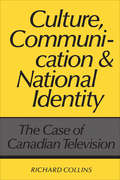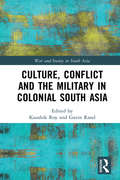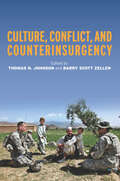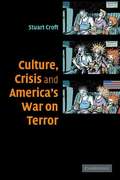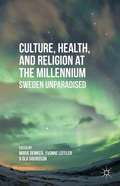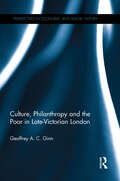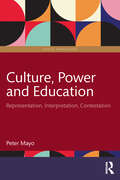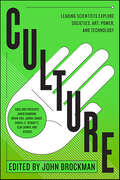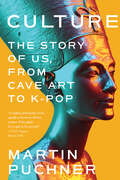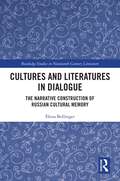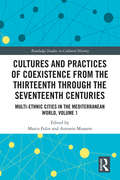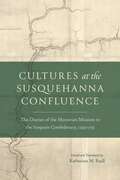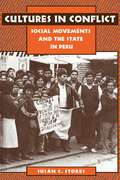- Table View
- List View
Culture under Cross-Examination: International Justice and the Special Court for Sierra Leone
by Tim KelsallThe international community created the Special Court for Sierra Leone to prosecute those who bore the greatest responsibility for crimes committed during the country's devastating civil war. Tim Kelsall examines some of the challenges posed by the fact that the Court operated in a largely unfamiliar culture, in which the way local people thought about rights, agency and truth-telling sometimes differed radically from the way international lawyers think about these things. By applying an anthro-political perspective to the trials, he unveils a variety of ethical, epistemological, jurisprudential and procedural problems, arguing that although touted as a promising hybrid, the Court failed in crucial ways to adapt to the local culture concerned. Culture matters, and international justice requires a more dialogical, multicultural approach.
Culture, Capitalism, and Democracy in the New America
by Richard Harvey BrownThe United States is in transit from an industrial to a postindustrial society, from a modern to postmodern culture, and from a national to a global economy. In this book Richard Harvey Brown asks how we can distinguish the uniquely American elements of these changes from more global influences. His answer focuses on the ways in which economic imperatives give shape to the shifting experience of being American. Drawing on a wide knowledge of American history and literature, the latest social science, and contemporary social issues, Brown investigates continuity and change in American race relations, politics, religion, conception of selfhood, families, and the arts. He paints a vivid picture of contemporary America, showing how postmodernism is perceived and felt by individuals and focusing attention on the strengths and limitations of American democracy.
Culture, Censorship and the State in Twentieth-century Italy
by Guido BonsaverThis book brings together literary critics, political historians, historians of literature, cinema and theatre and cultural sociologists, to elucidate a fundamental area of enquiry into modern Italian history: the nature and scope of relations between the state and the cultural sphere.
Culture, Communication and National Identity: The Case of Canadian Television
by Richard Collins‘There can be no political sovereignty without culture sovereignty.’ So argued the CBC in 1985 in its evidence to the Caplan/Sauvageau Task Force on Broadcasting Policy. Richard Collins challenges this assumption. He argues in this study of nationalism and Canadian television policy that Canada’s political sovereignty depends much less on Canadian content in television than has generally been accepted. His analysis focuses on television drama, at the centre of television policy in the 1980s.Collins questions the conventional image of Canada as a weak national entity undermined by its population’s predilection for foreign television. Rather, he argues, Canada is held together, not by a shared repertoire of symbols, a national culture, but by other social forces, notably political institutions. Collins maintains that important advantages actually and potentially flow from Canada’s wear national symbolic culture. Rethinking the relationships between television and society in Canada may yield a more successful broadcasting policy, more popular television programming, and a better understanding of the links between culture and the body politic. As the European Community moves closer to political unity, the Canadian case may become more relevant to Europe, which, Collins suggests, already fears the ‘Canadianization’ of its television. He maintains that a European multilingual society, without a shared culture or common European audio-visual sphere and with viewers watching foreign television, can survive successfully as a political entity – just as Canada has.
Culture, Conflict and the Military in Colonial South Asia
by Kaushik Roy Gavin RandThis book offers diverse and original perspectives on South Asia’s imperial military history. Unlike prevailing studies, the chapters in the volume emphasize both the vital role of culture in framing imperial military practice and the multiple cultural effects of colonial military service and engagements. The volume spans from the early East India Company period through to the Second World War and India’s independence, exploring themes such as the military in the field and at leisure, as well as examining the effects of imperial deployments in South Asia and across the British Empire. Drawing extensively on new archival research, the book integrates previously disparate accounts of imperial military history and raises new questions about culture and operational practice in the colonial Indian Army. This work will be of interest to scholars and researchers of modern South Asian history, war and strategic studies, military history, the British Empire, as well as politics and international relations.
Culture, Conflict, and Counterinsurgency
by Thomas H. Johnson Barry Scott ZellenCulture, Conflict, and Counterinsurgency
Culture, Crisis and America's War on Terror
by Stuart CroftThis 2006 book examines the development of the 'war on terror' discourse and its evidence in American life.
Culture, Health, and Religion at the Millennium: Sweden Unparadised
by Ola Sigurdson Marie Demker Yvonne LefflerThe book presents interpretations of culture, health, politics, and religion in Sweden today, Sweden transforms from the well-functioning but existentially bland economic wonder to a more fragmented and gloomy society. Contributors include scholars from film studies, literary studies, political science, religious studies and theology
Culture, Ideology and Politics (Routledge Revivals): Essays for Eric Hobsbawm
by Raphael Samuel and Gareth Stedman JonesFirst published in 1982, this book is inspired the ideas generated by Eric Hobsbawm, and has taken shape around a unifying preoccupation with the symbolic order and its relationship to political and religious belief. It explores some of the oldest question in Marxist historiography, for example the relationship of ‘base’ and ‘superstructure’, art and social life, and also some of the newest and most problematic questions, such as the relationship of dreams and fantasy to political action, or of past and present — historical consciousness — to the making of ideology. The essays, which range widely over period and place, are intended to break new ground and take on difficult questions.
Culture, Institution, and Development in China: The economics of national character (Routledge Studies in the Modern World Economy)
by C. Simon FanHow does culture shape history, and history shape culture? This book answers this question by bringing readers on a fascinating journey through the evolution of Chinese culture, political and legal institutions, and "national character" of historical and contemporary China. It illustrates how "national character" evolves endogenously along with an institutional environment through the use of economic theories. Recognizing the unique role of "personality" in violence and social order – important variables that contribute to successful economies, the book provides a meaningful take on "personality" from the "average personality" of a country’s people. It analyses the relationship between culture, institution and "national character", providing gainful, interesting insights into the monumental transformation of China.
Culture, Participation and Policy in the Municipal Public Park (Palgrave Studies in Cultural Participation)
by Abigail GilmoreThis book concerns the values and practices of participation in municipal public parks, and the connections they have with cultural policy, urbanism, and social life. Adopting a critical cultural policy lens, it identifies the park as a mundane but extraordinarily treasured place for the production and exchange of cultural values, regulation, resistance, and the practising of citizenship. Drawing on extensive mixed-methods research on everyday participation in diverse local cultural ecosystems in England and Scotland, the book examines the social lives of parks and their users, and the important public values that are generated through their common stewardship and usership. It presents case studies of parks and co-located museums as cultural public spheres, which promote both commoning and commodification. These are contextualized by histories of municipal parkmaking from the nineteenth century to the present and related to the making of local government and to other civic and cultural institutions.The book highlights contemporary issues of austerity, marketisation and de-municipalisation within local government in the context of urban development. It positions the public park as fundamental to democratic cultural governance and makes the case for the primacy of public trust, ownership, and park equity in safeguarding the right to the city.
Culture, Philanthropy and the Poor in Late-Victorian London (Perspectives in Economic and Social History)
by Geoffrey A. Ginn2018 Choice Outstanding Academic Title ******************************** The Late-Victorian cultural mission to London’s slums was a peculiar effort towards social reform that today is largely forgotten or misunderstood. The philanthropy of middle and upper-class social workers saw hundreds of art exhibitions, concerts of fine music, evening lectures, clubs and socials, debates and excursions mounted for the benefit of impoverished and working-class Londoners. Ginn’s vivid and provocative book captures many of these in detail for the first time. In refreshing our understanding of this obscure but eloquent activism, Ginn approaches cultural philanthropy not simply as a project of class self-interest, nor as fanciful ‘missionary aestheticism.’ Rather, he shows how liberal aspirations towards adult education and civic community can be traced in a number of centres of moralising voluntary effort. Concentrating on Toynbee Hall in Whitechapel, the People’s Palace in Mile End, Red Cross Hall in Southwark and the Bermondsey Settlement, the discussion identifies the common impulses animating practical reformers across these settings. Drawing on new primary research to clarify reformers’ underlying intentions and strategies, Ginn shows how these were shaped by a distinctive diagnosis of urban deprivation and anomie. In rebutting the common view that cultural philanthropy was a crudely paternalistic attempt to impose ‘rational recreation’ on the poor, this volume explores its sources in a liberal-minded social idealism common to both religious and secular conceptions of social welfare in this period. Culture, Philanthropy and the Poor in Late-Victorian London appeals to students and researchers of Victorian culture, moral reform, urbanism, adult education and philanthropy, who will be fascinated by this underrated but lively aspect of the period’s social activism.
Culture, Politics and Governing
by Patricia Mooney NickelCulture, Politics, and Governing: The Contemporary Ascetics of Knowledge Production investigates how the practices that govern the production of knowledge and culture have material consequences for how we experience everyday life. In a critical and interdisciplinary approach to governing, Patricia Mooney Nickel looks to artists and intellectuals including Gustav Klimt, Alexander Solzhenitsyn, Tino Sehgal, and Kenneth Goldsmith, to explore the themes of institutionalization, ontology, and valorization, as they relate to ascetics. These portraits demonstrate not only how contemporary rituals of knowledge production potentially inhibit the emergence of critical subjectivities, but also how such rituals have been resisted.
Culture, Power and Education: Representation, Interpretation, Contestation (Critical Interventions)
by Peter MayoEmploying Gramscian conceptions of hegemony, this book demonstrates the inextricable links between politics, education, culture and power.Based upon in-depth analyses of the theories of Antonio Gramsci, Lorenzo Milani, Paulo Freire, Henry Giroux, and bell hooks among others, this book shows how many hegemonic social relationships are fundamentally educational relationships. In doing so, Mayo demonstrates how popular culture, education, museums, and fine art are both sites of hegemony and contestation.This thought-provoking work will be of interest to students and scholars with an interest in sociology of art and culture, sociology of education, critical pedagogy, cultural studies, museum studies and social theory.
Culture, Power, and the State
by Prasenjit DuaraIn the early twentieth century, the Chinese state made strenuous efforts to broaden and deepen its authority over rural society. This book is an ambitious attempt to offer both a method and a framework for analyzing Chinese social history in the state-making era. The author constructs a prismatic view of village-level society that shows how marketing, kinship, water control, temple patronage, and other structures of human interaction overlapped to form what he calls the cultural nexus of power in local society. The author's concept of the cultural nexus and his tracing of how it was altered enables us for the first time to grapple with change at the village level in all its complexity. The author asserts that the growth of the state transformed and delegitimized the traditional cultural nexus during the Republican era, particularly in the realm of village leadership and finances. Thus, the expansion of state power was ultimately and paradoxically responsible for the revolution in China as it eroded the foundations of village life, leaving nothing in its place. The problems of state-making in China were different from those of eighteenth- and nineteenth-century Europe; the Chinese experience heralds the process that would become increasingly common in the emergent states of the developing world under the very different circumstances of the twentieth century.
Culture: Leading Scientists Explore Civilizations, Art, Networks, Reputation, and the Online Revolution (Best of Edge Series)
by John Brockman"Theway Brockman interlaces essays about research on the frontiers of science withones on artistic vision, education, psychology and economics is sure to buzzany brain." —Chicago Sun-Times, on This Will Change EverythingLaunchinga hard-hitting new series from Edge.org and Harper Perennial, editor JohnBrockman delivers this cutting-edge master class covering everything you needto know about Culture. With original contributions by the world’sleading thinkers and scientists, including Jared Diamond, Daniel C. Dennett,Brian Eno, Jaron Lanier,Nicholas Christakis, and others, Culture offers a mind-expanding primeron a fundamental topic. Unparalleled in scope, depth, insight and quality, Edge.org’s Culture is not to be missed.
Culture: The Story Of Us, From Cave Art To K-pop (The\oxford Research Centre In The Humanities/princeton University Press Lectures In European Culture Ser. #1)
by Martin PuchnerNew York Times Editors’ Choice “A mighty, polymathic work, equally at home in all four corners of the globe.… It is a gift to be savored.” —Chris Vognar, Boston Globe In Culture, acclaimed author, professor, and public intellectual Martin Puchner takes us on a breakneck tour through pivotal moments in world history, providing a global introduction to the arts and humanities in one engaging volume. What good are the arts? Why should we care about the past? For millennia, humanity has sought to understand and transmit to future generations not just the “know-how” of life, but the “know-why”—the meaning and purpose of our existence, as expressed in art, architecture, religion, and philosophy. This crucial passing down of knowledge has required the radical integration of insights from the past and from other cultures. In Culture, acclaimed author, professor, and public intellectual Martin Puchner takes us on a breakneck tour through pivotal moments in world history, providing a global introduction to the arts and humanities in one engaging volume. From Nefertiti’s lost city to the plays of Wole Soyinka; from the theaters of ancient Greece to Chinese travel journals to Arab and Aztec libraries; from a South Asian statuette found at Pompeii to a time capsule left behind on the Moon, Puchner tells the gripping story of human achievement through our collective losses and rediscoveries, power plays and heroic journeys, innovations, imitations, and appropriations. More than a work of history, Culture is an archive of humanity’s most monumental junctures and a guidebook for the future of us humans as a creative species. Witty, erudite, and full of wonder, Puchner argues that the humanities are (and always have been) essential to the transmission of knowledge that drives the efforts of human civilization.
Cultures Colliding: American Missionaries, Chinese Resistance, and the Rise of Modern Institutions in China
by John R HaddadAs incredible as it may seem, the American missionaries who journeyed to China in 1860 planning solely to spread the Gospel ultimately reinvented their entire enterprise. By 1900, they were modernizing China with schools, colleges, hospitals, museums, and even YMCA chapters. In Cultures Colliding, John R. Haddad nimbly recounts this transformative institution-building—how and why it happened—and its consequences. When missionaries first traveled to rural towns atop mules, they confronted populations with entrenched systems of belief that embraced Confucius and rejected Christ. Conflict ensued as these Chinese viewed missionaries as unwanted disruptors. So how did this failing movement eventually change minds and win hearts? Many missionaries chose to innovate. They built hospitals and established educational institutions offering science and math. A second wave of missionaries opened YMCA chapters, coached sports, and taught college. Crucially, missionaries also started listening to Chinese citizens, who exerted surprising influence over the preaching, teaching, and caregiving, eventually running some organizations themselves. They embraced new American ideals while remaining thoroughly Chinese. In Cultures Colliding, Haddad recounts the unexpected origins and rapid rise of American institutions in China by telling the stories of the Americans who established these institutions and the Chinese who changed them from within. Today, the impact of this untold history continues to resonate in China.
Cultures Colliding: American Missionaries, Chinese Resistance, and the Rise of Modern Institutions in China
by John R HaddadAs incredible as it may seem, the American missionaries who journeyed to China in 1860 planning solely to spread the Gospel ultimately reinvented their entire enterprise. By 1900, they were modernizing China with schools, colleges, hospitals, museums, and even YMCA chapters. In Cultures Colliding, John R. Haddad nimbly recounts this transformative institution-building—how and why it happened—and its consequences. When missionaries first traveled to rural towns atop mules, they confronted populations with entrenched systems of belief that embraced Confucius and rejected Christ. Conflict ensued as these Chinese viewed missionaries as unwanted disruptors. So how did this failing movement eventually change minds and win hearts? Many missionaries chose to innovate. They built hospitals and established educational institutions offering science and math. A second wave of missionaries opened YMCA chapters, coached sports, and taught college. Crucially, missionaries also started listening to Chinese citizens, who exerted surprising influence over the preaching, teaching, and caregiving, eventually running some organizations themselves. They embraced new American ideals while remaining thoroughly Chinese. In Cultures Colliding, Haddad recounts the unexpected origins and rapid rise of American institutions in China by telling the stories of the Americans who established these institutions and the Chinese who changed them from within. Today, the impact of this untold history continues to resonate in China.
Cultures Merging: A Historical and Economic Critique of Culture (The Princeton Economic History of the Western World #18)
by Eric L. Jones"Economists agree about many things--contrary to popular opinion--but the majority agree about culture only in the sense that they no longer give it much thought." So begins the first chapter of Cultures Merging, in which Eric Jones--one of the world's leading economic historians--takes an eloquent, pointed, and personal look at the question of whether culture determines economics or is instead determined by it. Bringing immense learning and originality to the issue of cultural change over the long-term course of global economic history, Jones questions cultural explanations of much social behavior in Europe, East Asia, the United States, Australia, and the Middle East. He also examines contemporary globalization, arguing that while centuries of economic competition have resulted in the merging of cultures into fewer and larger units, these changes have led to exciting new syntheses. Culture matters to economic outcomes, Jones argues, but cultures in turn never stop responding to market forces, even if some elements of culture stubbornly persist beyond the time when they can be explained by current economic pressures. In the longer run, however, cultures show a fluidity that will astonish some cultural determinists. Jones concludes that culture's "ghostly transit through history" is much less powerful than noneconomists often claim, yet it has a greater influence than economists usually admit. The product of a lifetime of reading and thinking on culture and economics, a work of history and an analysis of the contemporary world, Cultures Merging will be essential reading for anyone concerned about the interaction of cultures and markets around the world.
Cultures and Identities in Colonial British America (Anglo-America in the Transatlantic World)
by Robert Olwell Alan TullyNever truly a "new world" entirely detached from the home countries of its immigrants, colonial America, over the generations, became a model of transatlantic culture. Colonial society was shaped by the conflict between colonists' need to adapt to the American environment and their desire to perpetuate old world traditions or to imitate the charismatic model of the British establishment. In the course of colonial history, these contrasting impulses produced a host of distinctive cultures and identities.In this impressive new collection, prominent scholars of early American history explore this complex dynamic of accommodation and replication to demonstrate how early American societies developed from the intersection of American and Atlantic influences. The volume, edited by Robert Olwell and Alan Tully, offers fresh perspectives on colonial history and on early American attitudes toward slavery and ethnicity, native Americans, and the environment, as well as colonial social, economic, and political development. It reveals the myriad ways in which American colonists were the inhabitants and subjects of a wider Atlantic world.Cultures and Identities in Colonial British America, one of a three-volume series under the editorship of Jack P. Greene, aims to give students of Atlantic history a "state of the field" survey by pursuing interesting lines of research and raising new questions. The entire series, "Anglo-America in the Transatlantic World," engages the major organizing themes of the subject through a collection of high-level, debate-inspiring essays, inviting readers to think anew about the complex ways in which the Atlantic experience shaped both American societies and the Atlantic world itself.
Cultures and Literatures in Dialogue: The Narrative Construction of Russian Cultural Memory (Routledge Studies in Nineteenth Century Literature)
by Elena BollingerThis book addresses the narrative construction of Russian cultural memory in the work of Julian Barnes. It investigates how Barnes's texts tend to display a memory process as a transcultural mode of the creation of English and Russian national identities. Examining a need to revisit Russian canonical works, the detailed discursive analysis of the selected English texts exposes an intertextual remembering by duplication, thus contributing to the prevention of forgetting through the recuperation of still misrecollected cultural meanings. By creatively incorporating Russian intertextual elements into his work as a novelist, the author seems to insist on sweeping across and beyond national boundaries, revealing how frail the invention of tradition is when leading to the illusion of a solid collective memory and its political legitimation. The book considers not only a constructive dialogue between Barnes’s fiction and Russian classical literature, but also this writer’s interpretative, mostly imaginative, integration of Russian literature and culture into his work as a novelist. Exploring the double meaning of a literary metaphor as a mnemonic image of memory and a product of imagination, it offers a comprehensive analysis of Barnes’s texts which play with intertextuality as an efficient tool of displacement of official memory, providing a deeper understanding of historical and cultural processes related to the constantly moving architecture of transcultural memory.
Cultures and Practices of Coexistence from the Thirteenth Through the Seventeenth Centuries: Multi-Ethnic Cities in the Mediterranean World, Volume 1 (Routledge Studies in Cultural History #91)
by Marco Folin; Antonio MusarraThis book focuses on the ethnically composite, heterogeneous, mixed nature of the Mediterranean cities and their cultural heritage between the late middle ages and early modern times. How did it affect the cohabitation among different people and cultures on the urban scene? How did it mold the shape and image of cities that were crossroads of encounters, but also the arena of conflict and exclusion? The 13 case studies collected in this volume address these issues by exploring the traces left by centuries of interethnic porosity on the tangible and intangible heritage of cities such as Acre and Cyprus, Genoa and Venice, Rome and Istanbul, Cordoba and Tarragona.
Cultures at the Susquehanna Confluence: The Diaries of the Moravian Mission to the Iroquois Confederacy, 1745–1755 (Pietist, Moravian, and Anabaptist Studies)
by Katherine M. Faull and David MinderhoutLocated at the confluence of the north and west branches of the Susquehanna River, Shamokin was a significant historical settlement in the region that became Pennsylvania. By the time the Moravians arrived to set up a mission in the 1740s, Shamokin had been a site of intertribal commerce and refuge for the Native peoples of Pennsylvania for several centuries. It served first as a Susquehannock, then a Shawnee, and then a primarily Lenape settlement and trading post, overseen by the Oneida leader and diplomat Shikellamy.Cultures at the Susquehanna Confluence is an annotated translation of the diaries documenting the Moravian mission to the area. Unlike other missions of the time, the Moravians at Shamokin integrated their work and daily life into the diverse cultures they encountered, demonstrating an unusual compromise between the Church’s missionary impetus and the needs of the Six Nations of the Iroquois. The diaries counter the dominant vision of the area around Shamokin as a sinister place, revealing instead a nexus of vibrant cultural exchange where women and men speaking Lenape, Mohican, English, and German collaborated in the business of survival at a pivotal time.The Shamokin diaries, which until now existed only in manuscript form in difficult-to-read German script in the Moravian Archives in Bethlehem, Pennsylvania, allow today’s readers to experience the Susquehanna confluence and the rich intercultural exchanges that took place there between Europeans and Native Americans.
Cultures in Conflict: Social Movements and the State in Peru
by Susan C. StokesIn this vivid ethnography set in contemporary Peru, Susan Stokes provides a compelling analysis of the making and unmaking of class consciousness among the urban poor. Her research strategy is multifaceted; through interviews, participant observation, and survey research she digs deeply into the popular culture of the social activists and shantytown residents she studies. The result is a penetrating look at how social movements evolve, how poor people construct independent political cultures, and how the ideological domination of oppressed classes can shatter.This work is a new and vital chapter in the growing literature on the formation of social movements. It chronicles the transformation of Peru's poor from a culture of deference and clientelism in the late 1960s to a population mobilized for radical political action today.



